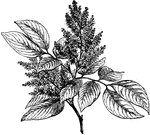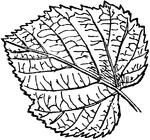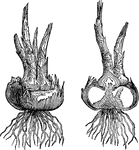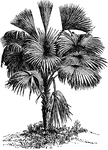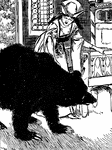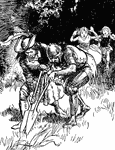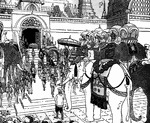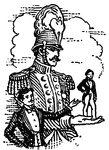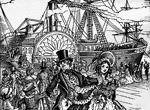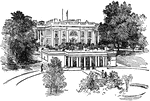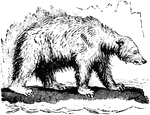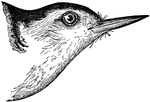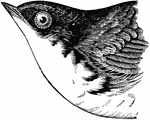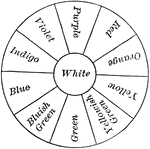
Complementary color wheel
"Any two colors standing opposite each other are complementary to each other. If such colors are blended,…
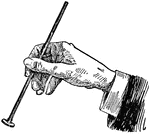
Hand with Proof-plane
"A proof-plane may be made by cementing a bronze cent or a disk of gilt paper to a thin insulating handle,…
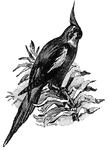
Cockatiel
A bird about 12 inches long, with a pointed crest somewhat like a cockatoo's. Long exserted midle tail…
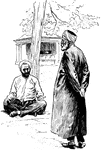
Turkish men
"There are scores of men in long gowns, with white, red, blue, or green turbans about their heads."…
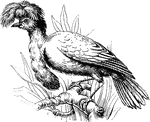
Umbrellabird
"The Umbrella Bird is a native of Peru. It is about the size of a crow, with deep black plumage; the…
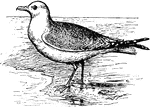
Gull
Gulls are in general medium to large birds, typically grey or white, often with black markings on the…
Wampum
A wampum was made of pieces of shining shell, strung, like beads, on strips of deerskin. With some Indians…
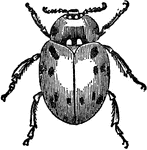
Ladybird
A class of small insects or beetles found commonly on plants and trees. They are noted for their various…
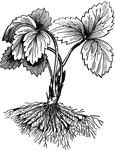
Plant with Roots Pruned
"This pruning or shortening of the roots causes the production of a new set of fibres from the severed…

Durand strawberry
"Large oblong or oblong conical, sometimes flattene, seeds but slightly imbedded; color scarlet; flesh…
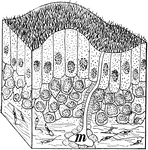
Section of Nasal Tissue
"A tiny block of tissue from the membrane lining the inner surface of the nose. Note the hundreds of…
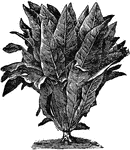
Lettuce
An annual plant cultivated in gardens, and which serves as a salad. There are many species, most of…
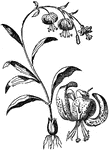
Tiger Lily
An ornamental plant of the genius lilium, characterized by an erect stem from a scaly bulb, numerous…

Lily of the Valley
A genus of plants of the family liliaceae, native to the bushy places of America and Eurasia. It has…
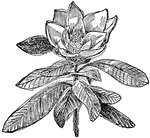
Magnolia
A genus of ornamental shrubs and trees, native to North America, China, India, Japan, and other portions…
Consumers' League Label
"The Consumer's League is trying to raise standards in relation to the sanitation of workrooms and shops…

Millet
A grass extensively cultivated in some sections of the United States for forage. There are numerous…
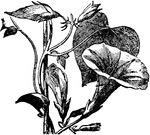
Morning Glory
A family of climbing plants, including many species. They are familiarly known as favorite flowering…
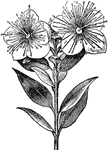
Myrtle
A genus of plants native to western Asia, but now naturalized quite extensively in Europe and other…

Nasturtium
A genus of aquatic herbs of the mustard famil, known generally as the water-cresses. The leaves in most…
Herati Design
Also known as the fish, twin fish and Feraghan designs. Better known as the Herati. It originated in…

Herati Design
Also known as the fish, twin fish and Feraghan designs. Better known as the Herati. It originated in…

Herati Design
Also known as the fish, twin fish and Feraghan designs. Better known as the Herati. It originated in…

Herati Design
Also known as the fish, twin fish and Feraghan designs. Better known as the Herati. It originated in…

Herati Design
Also known as the fish, twin fish and Feraghan designs. Better known as the Herati. It originated in…

Herati Design
Also known as the fish, twin fish and Feraghan designs. Better known as the Herati. It originated in…
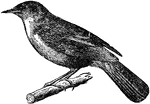
Nightingale
A bird of song, belonging to the thrush family. The plumage of both sexes is alike, being reddishbrown…
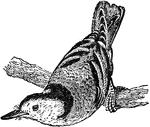
Nuthatch
A genus of birds found widely distributed in Eurasia, which somewhat resemble the starlings and woodpeckers.…

Tree Design
Sometimes called the tree of life. Always associated with religious belief. It symbolizes Divine power…
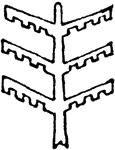
Tree Design
Sometimes called the tree of life. Always associated with religious belief. It symbolizes Divine power…


